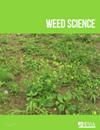Interference of Brassicaceae weeds (Brassica tournefortii, Rapistrum rugosum, and Sisymbrium thellungii) in Chickpeas
IF 2.1
2区 农林科学
Q2 AGRONOMY
引用次数: 0
Abstract
African mustard (Brassica tournefortii Gouan), turnipweed [Rapistrum rugosum (L.) All.], and African turnipweed (Sisymbrium thellungii O.E. Schulz) are common broadleaf weeds in chickpea (Cicer arietinum L.) crops, particularly under dryland regions of eastern Australia. Information on crop yield losses and the seed production potential for these weeds are limited in chickpea. Field studies were conducted in the winter seasons of 2020 and 2021 in eastern Australia with different densities of the three weeds (B. tournefortii, R. rugosum, and S. thellungii) in chickpea. Based on the sigmoid model, chickpea yield was reduced by 50% at 11 plants m-2 of B. tournefortii. Based on hyperbola models, a 50% yield reduction of chickpea occurred at 5, and 25 plants m−2 of R. rugosum, and S. thellungii, respectively. Based on the linear model, B. tournefortii, R. rugosum, and S. thellungii produced a maximum of 448,000, 206,700, and 869,400, seeds m−2, respectively. At chickpea harvest, the low seed retention (<55%) of B. tournefortii and S. thellungii suggests limited opportunities for harvest weed seed control, and the seed rain of these weeds may enrich the weed seedbank in the soil. At crop harvest, the seed retention of R. rugosum was found to be greater than 90%, suggesting that it is a suitable candidate for harvest weed seed control. This study demonstrated that R. rugosum could cause a greater reduction in chickpea yield compared with B. tournefortii and S. thellungii. Furthermore, it is recommended to restrict seed rain of B. tournefortii and S. thellungii by not allowing the plants to produce seeds in order to reduce their weed seedbank in the soil. The information generated from this study could aid in strengthening integrated weed management in chickpea.十字花科杂草对鹰嘴豆的干扰
非洲芥菜(Brassica tournefortii Gouan)、芜菁(Rapistrom rugosum(L.)All.]和非洲芜菁(Sisymbrium thellungii O.E.Schulz)是鹰嘴豆(Cicer arietinum L.)作物中常见的阔叶杂草,尤其是在澳大利亚东部干旱地区。关于鹰嘴豆作物产量损失和这些杂草的种子生产潜力的信息有限。2020年和2021年冬季,在澳大利亚东部对鹰嘴豆中三种杂草(B.tournefortii、R.rugosum和S.thellungii)的不同密度进行了实地研究。根据S型模型,11株m-2的B.tournefortii鹰嘴豆产量下降了50%。根据双曲线模型,鹰嘴豆的产量分别减少了50%,分别发生在5株和25株米2的R.rugosum和S.thellungii。根据线性模型,B.tournefortii、R.rugosum和S.thellungii分别产生了最多448000、206700和869400粒m-2种子。在鹰嘴豆收获时,B.tournefortii和S.thellungii的低种子保留率(<55%)表明收获杂草种子控制的机会有限,这些杂草的种子雨可能会丰富土壤中的杂草种子库。在作物收获时,发现鲁格苏的种子保留率大于90%,这表明它是控制收获杂草种子的合适候选者。这项研究表明,与B.tournefortii和S.thellungii相比,R.rugosum可能导致鹰嘴豆产量的更大下降。此外,建议通过不允许植物产生种子来限制B.tournefortii和S.thellungii的种子雨,以减少其在土壤中的杂草种子库。这项研究产生的信息可能有助于加强鹰嘴豆的杂草综合管理。
本文章由计算机程序翻译,如有差异,请以英文原文为准。
求助全文
约1分钟内获得全文
求助全文
来源期刊

Weed Science
农林科学-农艺学
CiteScore
4.60
自引率
12.00%
发文量
64
审稿时长
12-24 weeks
期刊介绍:
Weed Science publishes original research and scholarship in the form of peer-reviewed articles focused on fundamental research directly related to all aspects of weed science in agricultural systems. Topics for Weed Science include:
- the biology and ecology of weeds in agricultural, forestry, aquatic, turf, recreational, rights-of-way and other settings, genetics of weeds
- herbicide resistance, chemistry, biochemistry, physiology and molecular action of herbicides and plant growth regulators used to manage undesirable vegetation
- ecology of cropping and other agricultural systems as they relate to weed management
- biological and ecological aspects of weed control tools including biological agents, and herbicide resistant crops
- effect of weed management on soil, air and water.
 求助内容:
求助内容: 应助结果提醒方式:
应助结果提醒方式:


